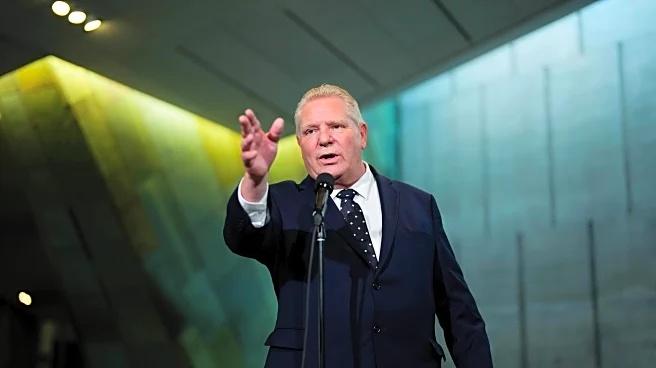What's Happening?
President Donald Trump has signed an order to extend tariff relief for automakers importing vehicle parts into the United States. This extension allows companies to continue offsetting 3.75% of a vehicle's
list price, a program initially set to be reduced and eventually eliminated. The relief is now extended through 2030. Concurrently, Trump formalized a new 25% tariff on imported medium and heavy-duty trucks and parts, effective November 1. This decision follows a Section 232 investigation into truck imports, assessing their impact on national security. The tariffs aim to boost domestic manufacturing and penalize countries perceived to be exploiting U.S. trade policies. While imported trucks will face steep duties, those qualifying under the U.S.-Mexico-Canada trade agreement (USMCA) will receive favorable treatment, with only non-U.S. content subject to the 25% tariff.
Why It's Important?
The extension of tariff relief for automakers and the imposition of new duties on trucks reflect President Trump's ongoing strategy to bolster domestic manufacturing. By maintaining the offset program for vehicle parts, U.S.-based production is incentivized, potentially benefiting domestic automakers. The new truck tariffs, however, could impact importers, particularly those sourcing from Mexico and Canada, which account for a significant portion of U.S. heavy truck imports. This move may strain trade relations with these countries, as evidenced by Mexico's declining exports of heavy vehicles to the U.S. The tariffs could lead to increased costs for importers and potentially higher prices for consumers, affecting the automotive industry and related sectors.
What's Next?
The implementation of the new tariffs on trucks and parts will begin on November 1, with the Commerce Department expected to establish a process to target non-U.S. content in truck parts. Importers will need to navigate these changes, potentially seeking adjustments in sourcing strategies to mitigate the impact of tariffs. The U.S.-Mexico-Canada trade agreement will play a crucial role in determining the extent of tariff relief for qualifying imports. As trade negotiations continue, Mexico and Canada may seek further agreements with the U.S. to alleviate the impact of these tariffs. The automotive industry will closely monitor these developments, assessing their implications for production costs and market dynamics.
Beyond the Headlines
The tariff changes underscore the broader trade tensions between the U.S. and its neighbors, particularly Mexico and Canada. These tensions could have long-term implications for North American trade relations and economic integration. The focus on national security in trade policy highlights the intersection of economic and geopolitical considerations in U.S. trade strategy. Additionally, the emphasis on domestic manufacturing aligns with broader economic policies aimed at revitalizing U.S. industry, potentially influencing future trade agreements and economic policies.













